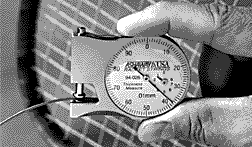|
|

String Gauge: The Basic Choice
By Steve Crandall
Vice President, Sales & Marketing
Ashaway Racket Strings
 If you read my feature in the last issue, you may recall the assertion that racquet string plays a critical role in how you play. In this regular column on racquetball string and stringing, we're going to look at string from the player's point of view. If you have questions on the subject that I fail to cover, please feel free to direct them to me via the editor of this magazine, and I'll try to address them in print. If you read my feature in the last issue, you may recall the assertion that racquet string plays a critical role in how you play. In this regular column on racquetball string and stringing, we're going to look at string from the player's point of view. If you have questions on the subject that I fail to cover, please feel free to direct them to me via the editor of this magazine, and I'll try to address them in print.
The most important variable in racquetball string is its gauge, also known as diameter or thickness. Tournament players may boast about using super-responsive 18-gauge string, but what does that mean, and how does string gauge affect play?
String gauge is designated numerically, with thicker strings having lower numbers, as shown in the table:
Racquet String Diameters
| Gauge | Diameter |
| 15 | 1.41 - 1.49 mm |
| 15L | 1.33 - 1.41 mm |
| 16 | 1.26 - 1.34 mm |
| 17 | 1.16 - 1.26 mm |
| 18 | 1.06 - 1.16 mm |
The gauge designations were originally based on standard industrial wire gauge sizes, but as manufacturers began developing racquet string in a variety of different sizes, the industry agreed that the numbers would represent a range of allowable diameters, rather than a single, exact size. All consumer string packaging indicates the size at least as a gauge designation: some packages include the diameter in millimeters as well.
The "L" in the 15L gauge stands for "light." Note how 15L and 16 gauge overlap, so that diameters of 1.33 mm and 1.34 mm can be properly called either one. Within that overlap, the only difference is a question of marketing.
A note of caution: if you're going to measure string thickness with a wire gage or a micrometer, make sure you do it with the string off the racquet, under no tension -- in other words, before the racquet is strung. Thickness decreases when a string is stretched at 25 lb. to 50 lb. of tension, and a reading taken under those conditions can be misleading.
As you would suspect, thick and thin strings perform differently in the racquet. No one size is best for all players. Different playing styles lead players to choose different combinations of performance characteristics. We'll take up just one of the properties here -- that of durability.
Thick string lasts longer than thin string. Assuming that two strings are made of the same materials, and use the same construction, the thinner one will break more easily. Simple, huh? This doesn't necessarily apply if you're comparing a thin, premium-quality string with a thick junk string, but as a rule of thumb, it's pretty reliable.
There are two main causes of string breakage. The first is notching. As you hit the ball, the cross strings (or "crosses" -- the shorter, "horizontal" ones) are pounded against the main strings (or "mains" -- the longer, "vertical" ones) several hundred times in the course of a game. The crosses slowly cut notches into the mains, and eventually they cut right through. Obviously, a thicker string will stand up to deeper notching before it breaks. By the way, it's almost always the mains that break first.
The second major cause of breakage is over-stretching, which can occur during a particularly hard or off-center killshot. This is especially so if you hit the ball near the head of the frame instead of in the sweet spot. The string wants to stretch equally on both sides of the ball, and on a mis-hit, there's not much string to work with on one side: it tries to stretch too much, and it breaks.
So, is a thicker string necessarily preferable? Of course not. Durability is just one desirable characteristic. Thinner strings, for example, give a player better response. There's also power, cost, control, "feel," and a few others properties to consider and balance against one another when you're replacing your strings. We'll get to all of these in future columns.
This article previously appeared in Racquetball Magazine.
|